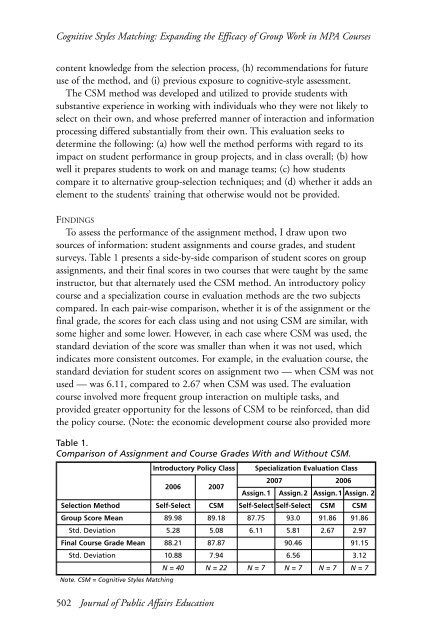JOURNAL OF PUBLIC AFFAIRS EDUCATION - National ...
JOURNAL OF PUBLIC AFFAIRS EDUCATION - National ...
JOURNAL OF PUBLIC AFFAIRS EDUCATION - National ...
You also want an ePaper? Increase the reach of your titles
YUMPU automatically turns print PDFs into web optimized ePapers that Google loves.
Cognitive Styles Matching: Expanding the Efficacy of Group Work in MPA Courses<br />
content knowledge from the selection process, (h) recommendations for future<br />
use of the method, and (i) previous exposure to cognitive-style assessment.<br />
The CSM method was developed and utilized to provide students with<br />
substantive experience in working with individuals who they were not likely to<br />
select on their own, and whose preferred manner of interaction and information<br />
processing differed substantially from their own. This evaluation seeks to<br />
determine the following: (a) how well the method performs with regard to its<br />
impact on student performance in group projects, and in class overall; (b) how<br />
well it prepares students to work on and manage teams; (c) how students<br />
compare it to alternative group-selection techniques; and (d) whether it adds an<br />
element to the students’ training that otherwise would not be provided.<br />
FINDINGS<br />
To assess the performance of the assignment method, I draw upon two<br />
sources of information: student assignments and course grades, and student<br />
surveys. Table 1 presents a side-by-side comparison of student scores on group<br />
assignments, and their final scores in two courses that were taught by the same<br />
instructor, but that alternately used the CSM method. An introductory policy<br />
course and a specialization course in evaluation methods are the two subjects<br />
compared. In each pair-wise comparison, whether it is of the assignment or the<br />
final grade, the scores for each class using and not using CSM are similar, with<br />
some higher and some lower. However, in each case where CSM was used, the<br />
standard deviation of the score was smaller than when it was not used, which<br />
indicates more consistent outcomes. For example, in the evaluation course, the<br />
standard deviation for student scores on assignment two — when CSM was not<br />
used — was 6.11, compared to 2.67 when CSM was used. The evaluation<br />
course involved more frequent group interaction on multiple tasks, and<br />
provided greater opportunity for the lessons of CSM to be reinforced, than did<br />
the policy course. (Note: the economic development course also provided more<br />
Table 1.<br />
Comparison of Assignment and Course Grades With and Without CSM.<br />
Note. CSM = Cognitive Styles Matching<br />
502 Journal of Public Affairs Education<br />
Introductory Policy Class Specialization Evaluation Class<br />
2006 2007<br />
2007 2006<br />
Assign.1 Assign.2 Assign.1 Assign. 2<br />
Selection Method Self-Select CSM Self-Select Self-Select CSM CSM<br />
Group Score Mean 89.98 89.18 87.75 93.0 91.86 91.86<br />
Std. Deviation 5.28 5.08 6.11 5.81 2.67 2.97<br />
Final Course Grade Mean 88.21 87.87 90.46 91.15<br />
Std. Deviation 10.88 7.94 6.56 3.12<br />
N = 40 N = 22 N = 7 N = 7 N = 7 N = 7

















